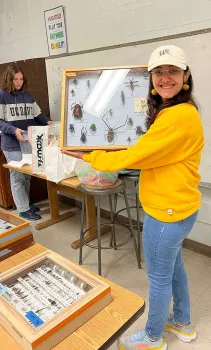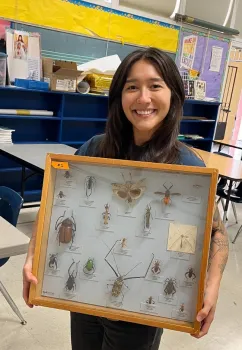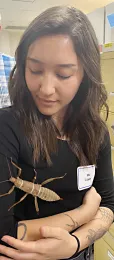
The Equity in Science, Technology, Engineering, Math and Entrepreneurship (ESTEME) facilitates the after-school science program for middle school students.
The students, representing fifth to eighth grades, and ranging in age from 10 to 14, learned about insect science, the importance of insect collections, and played “Bug Bingo.”
In Bug Bingo, the students answered such questions as:
- A bug that eats other bugs
- A bug that migrates
- A bug that lives in water
- A bug that is hairy
- A bug that is a pest
- A bug that you think looks silly
- A bug that is a pollinator
- Two bugs that look alike
- A bug you don't like
“Once they got Bingo, they won a prize,” Edwards said.
Each student also "invented" a bug, pinned it with toothpicks, and labeled it. Edwards and Lippey also shared insect collections borrowed from the Bohart Museum of Entomology, home of eight million insect specimens.
Edwards studies with medical entomologist-geneticist Geoffrey Attardo, associate professor of entomology, while Lippey's major professors are insect ecologist Jay Rosenheim, UC Davis distinguished professor, and urban landscape entomologist Emily Meineke, assistant professor.
ESTEME, established in 2017, is sponsored by the UC Davis Student Recruitment and Retention Center and the UC Davis College of Biological Sciences' Initiative. Diversity, Equity and Justice (DEIJ Grant.

CC Edwards. In her graduate studies, Edwards investigates the physiological mechanisms underlying pyrethroid resistance in Aedes aegypti, the yellow fever mosquito. She was a McNair scholar at Baylor University, where she completed her undergraduate degree in cell and molecular biology in May 2021. "I got interested in the mosquito field through my undergraduate research of studying the sensory and oviposition responses of Aedes aegypti in relation to the compound geosmin," she says on the Attardo lab website. "I went on to do my masters at Texas Tech University under the advisement of Dr. Corey Brelsfoard. I graduated in the summer of 2023. I investigated the effects of microplastics in relation to the mosquitoes Aedes aegypti and Aedes albopictus (the Asian tiger mosquito)."

"Though my research interests are broad," Lippey writes, "they generally center around the complexity of global change ecology and how insect interactions have responded to a rapidly changing world in the Anthropocene. I'm specifically intrigued by changes in ecological processes over various spatial and temporal scales, and how multiple simultaneous spatial and temporal dynamics further complicate the changes we observe across insects."
In her graduate studies, Lippey is exploring "insect responses to interactions between multiple global change drivers such as land use change (agricultural intensification and urbanization) and other anthropogenic drivers like warming climate, extreme climate events, and pesticide use."
Lippey was recently featured in a UC Davis article titled "Scientists and Their Science Tattoos" in which UC Davis professors and graduate students shared their tattoos with science news intern Malia Reiss of UC Davis Strategic Communications. Lippey's tattoos include Japanese rhinoceros beetles, a centipede, backwimmer, Madagascar hissing cockroach, cicada (emerging), a worm and a Darwin moth. "I did the worm myself," she said.

